Particle Size Distribution Measurement by the Laser Diffraction/Scattering Method Part1
Particle Size Distribution with Laser Diffracted/Scattered Light
With this method, the particle group is irradiated with laser light and the particle size distribution is calculated from the light intensity distribution pattern of the diffracted/scattered light emitted from that particle group.
| The following describes the principle of measurement of particle size distribution adopted on the SALD Series Laser Diffraction Particle Size Analyzer. |
Light Intensity Distribution Pattern Which Arise from Particles
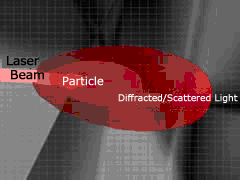
When particles are irradiated with a laser beam, light is emitted in various directions - forwards/backwards, up/down and left/right - from those particles. This light is called "diffracted/scattered light".
For the intensity of diffracted/scattered light, a fixed spatial pattern is formed in the direction that the light is emitted. This is referred to as the "light intensity distribution pattern."
This light intensity distribution pattern is known to change to various shapes according to the particles size.
■ Light intensity distribution pattern generated from 5 µm size particles
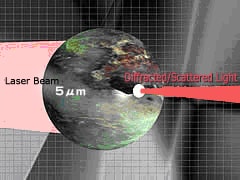
This is the light intensity distribution pattern of diffracted/scattered light emitted from 5 µm size particles.
In this case, diffracted/scattered light emitted from particles concentrates in the forward direction (laser beam travel direction).
Compared with light in the forward direction, light scattered and diffracted in other directions is very much weaker.
When larger size particles are measured, diffracted/scattered light concentrates even more in the forward direction.
■ Light intensity distribution pattern generated from 1 µm size particles
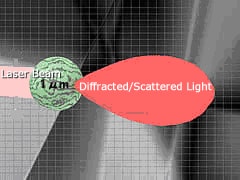
This is the light intensity distribution pattern of diffracted/scattered light emitted from 1 µm size particles. As the particle size becomes smaller, the pattern of the diffracted/scattered light spreads slightly to the periphery away from the forward direction (laser beam travel direction).
■ Light intensity distribution pattern generated from 0.1 µm size particles
This is the light intensity distribution pattern of diffracted/scattered light emitted from 0.1 µm size particles. As the particle size becomes smaller, light towards the sides (up/down and left/right directions) and back (opposite the laser beam travel direction) becomes stronger. The light pattern spreads in all directions just like a "cocoon" or "gourd."
The Three Light Intensity Distribution Patterns Shown in a Diagram
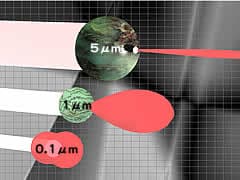
Now, let's try arranging the three light intensity distribution patterns described so far side by side.
You can tell how the light intensity distribution pattern of diffracted/scattered light changes according to the size of the particle.
There is a 1:1 corresponding relationship between the size of the particle and light intensity distribution pattern.
In other words, you can tell the size of particles by detecting the light intensity distribution pattern.
Light Intensity Distribution Pattern Which Arise from Particle Group
In actual particle size distribution measurement, the measurement target is not just one particle; it is a particle group made up of numerous particles. A particle group comprises a mixture of multiple particles of different sizes, and the light intensity distribution pattern emitted from the particle group is the result of overlaid diffracted/scattered light from each respective particle.
By detecting and analyzing this light intensity distribution pattern, you can find out the particle size distribution, that is, what particle sizes are present in what proportions.
The above is the basic way of thinking behind particle size distribution measurement using the laser diffraction/dispersion method.
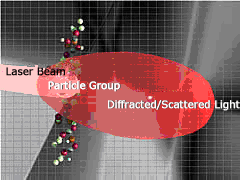
In conclusion, the key point is that particle size is found by using NOT the intensity of light but changes in the pattern according to particle size.


